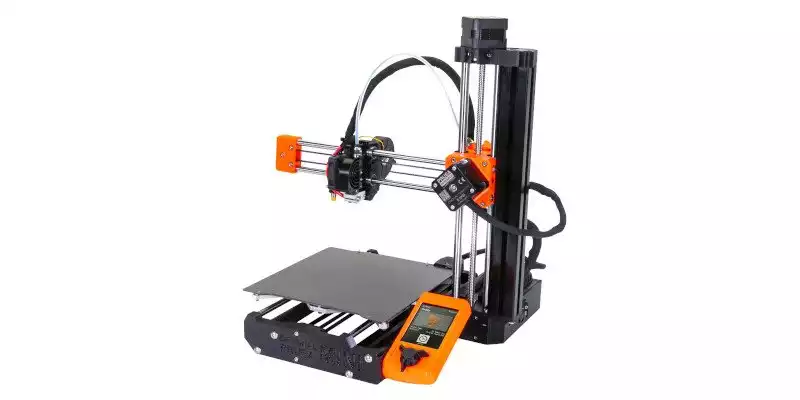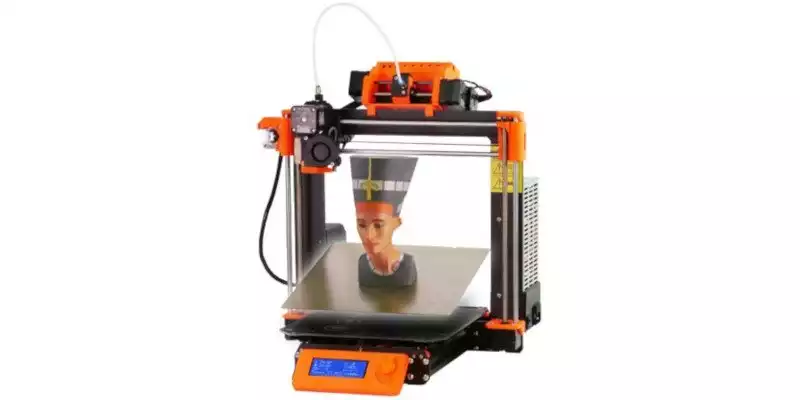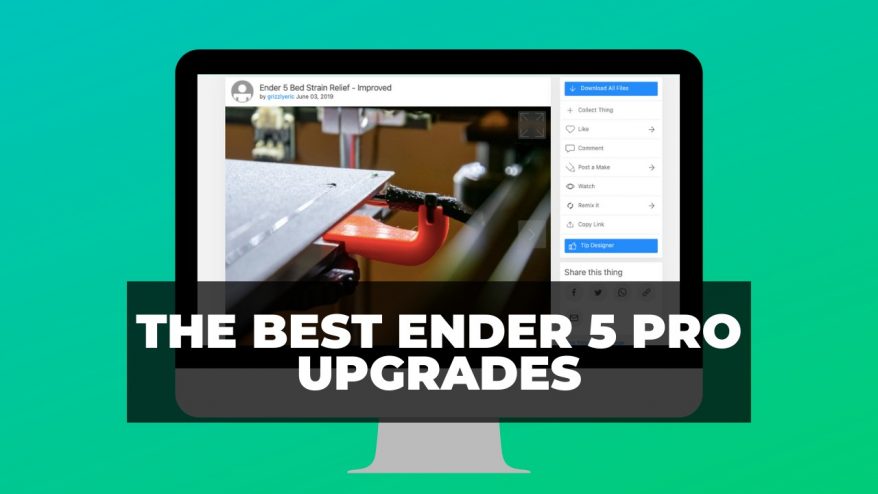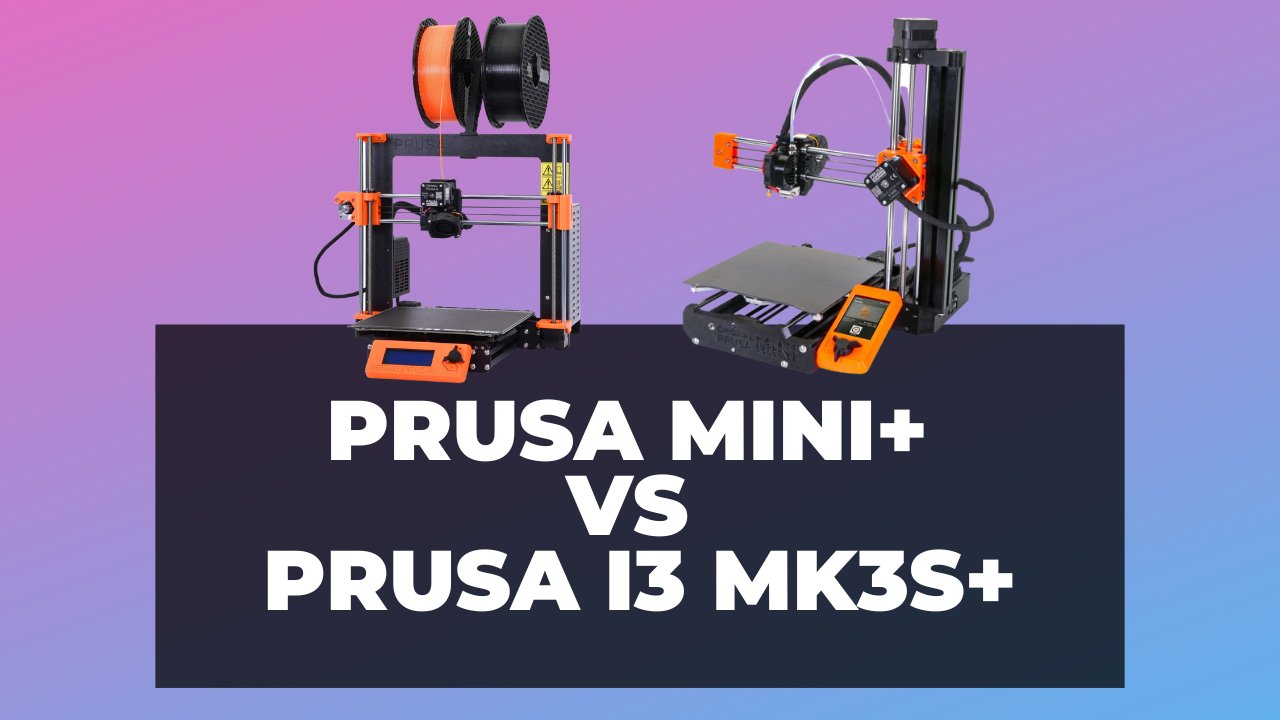
In this article we’re comparing the Prusa Mini+ vs Prusa i3 MK3S+. The Mini+ and the i3 MK3S+ are the newest variations of the Mini and i3 and are equipped with the best features for their price classes.
Overall verdict: if you’re on a budget, then I recommend you pick up the Mini+, as long as you don’t need to print large helmets or prototypes. For all other uses, I still recommedn the i3 MK3S+, as it’s just generally more of a sturdy all-rounder, and such great value still at the price.
|
|
|
|
$399
|
$999
|
|
Build Volume:
180 x 180 x 180 mm
|
Build Volume:
210 x 250 x 210 mm
|
|
Layer Height:
50 - 250 microns
|
Layer Height:
50 - 350 microns
|
|
Extruder Type:
Bowden extruder
|
Extruder Type:
Direct Drive extruder
|
|
Max extruder temp:
280°C
|
Max extruder temp:
300°C
|
|
Max bed temp:
100°C
|
Max bed temp:
120°C
|
|
Filament Compatibility:
PLA, PETG, ABS, ASA, PC, PP, TPU
|
Filament Compatibility:
PLA, PETG, ABS, ASA, PC, PP TPU, nylons, flexibles, polycarbonate, carbon fibers
|
|
|
I’ll go over all of the major similarities and differences (there are plenty of both) for these two printers.
To make things easier, we’ll talk about key features like filament compatibility, price, upgradeability, reliability, and build volume – plus how that will restrict you.
Let’s get started.
Prusa Mini+ vs Prusa i3 MK3S+: A Quick Summary
Prusa Mini+
- Price: Check latest price at Prusa here
- Printing technology: FDM
- Build volume: 180 x 180 x 180 mm
- Filament compatibility: PLA, PETG, ABS, ASA, PC, PP, TPU
- Layer height: 50 – 250 microns
- Printing accuracy: ± 0.1 mm
- Max extruder temp: 280°C
- Max bed temp: 100°C
- Connectivity: USB, SD Card
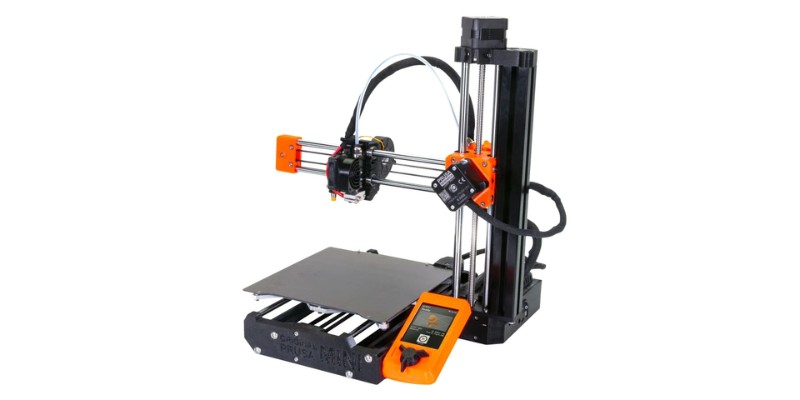
As an upgrade to the original Prusa Mini, the Mini+ serves most hobbyists quite well. It has a build volume of 180 x 180 x 180 mm. Most mid-range and budget printers, which are often Prusa clones, use a build volume of closer to 220 x 220 x 250 mm.
You have to be okay with the miniature build volume to be interested in the Mini+. But beyond that, the max extruder temp of 280°C and bed temp of 100°C will give you plenty of options for filaments.
Picky, high-temp filaments like carbon fibers or nylons are beyond the Mini+’s capabilities. Aside from that, you have access to all the basics like PLA, PETG, ABS, ASA, PP, and low-temperature PC filaments. You can also work with TPU if you want to play with a flexible filament.
One thing you should keep in mind is that the Mini+ uses a Bowden extruder. In this extruder type, the actual extruder is mounted on the printer’s frame and is connected to the hot-end with a PTFE tube. The Mini+ has a metal nozzle and hot end, which is why it can reach 280°C without breaking down.
Unfortunately, PTFE tubes are all vulnerable to clogging caused by shrinking after consistent exposure to high heats. There were dozens of reports of the Mini+ PTFE tube shrinking, especially after the initial release– but you’re likely to get a nice, long lifespan of a couple years if you’re only using PLA.
The Bowden setup has some implications about extruder-related printer hiccups, extruder maintenance, and even how easy it is to use certain filaments. We’ll talk about this more in-depth in later sections.
With minimal setup or tinkering and consistent performance, the Prusa Mini+ is a good option for a wide range of 3D printing enthusiasts – including professors, print farmers, and independent, small hobbyists. But it’s definitely not the best option if you want to print large designs or use specialty filaments.
All the reliability of the Prusa MK3S+, but in a cheaper and smaller pacakge.
Prusa i3 MK3S+
- Price: Check latest price at Prusa here / Amazon here
- Printing technology: FDM
- Build volume: 210 x 250 x 210 mm
- Filament compatibility: PLA, PETG, ABS, ASA, PC, PP TPU, nylons, flexibles, polycarbonate, carbon fibers
- Layer height: 50 – 350 microns
- Printing accuracy: ± 0.1 mm
- Max extruder temp: 300°C
- Max bed temp: 120°C
- Connectivity: USB, SD Card
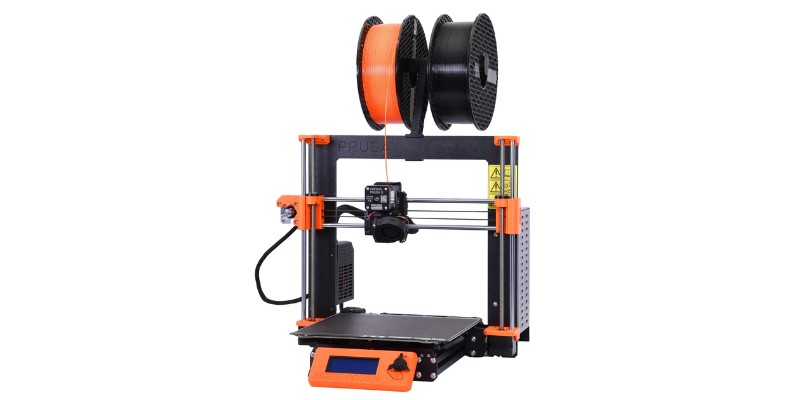
For a higher price, Prusa’s i3 series trumps the features of the Mini series. The i3 MK3S+ is no exception when compared to the Mini+.
To start with, it has a significantly larger build volume of 210 x 250 x 210 mm. This is still a bit smaller than printers like the Ender 3 S1 Pro (which reaches 220 x 220 x 270 mm), but the MK3S+ does give you a decent amount of room to play with. You can read more about Ender 3 comparisons in our Prusa i3 MK3S+ vs Ender 3 3D printer comparison.
One of the best features of this printer is the wide range of filaments that you can use with it. You’re rarely going to be limited by max temperatures, since the MK3S+ can reach an extruder temp of 300°C and a bed temp of 120°C.
This gives you access to all of the typical filaments (PLA, PETG, ABS, ASA, PC, PP TPU) and specialty filaments like nylons, carbon fibers, and other flexible filaments. It’s also plenty reliable, as you can expect from a Prusa printer.
Although the MK3S+ is just shy of the prices of truly high-end printers, it can still make you feel like you’re getting a high-end product. It’s equipped with ease-of-use features like auto bed leveling, a filament runout sensor, and has a revamped direct drive extruder that allows for easier maintenance.
All in all, the Prusa i3 MK3S+ is an ideal printer for those who want to minimize tinkering and maximize reliability with a wide range of filaments. If you can stomach the higher price, it will be able to print significantly more than the Mini– both in filament types and size of prints.
The best 3D printer kit of all time. If you have $1,000, this is some of the best value you can get.
The Similarities
They’re from two distinct printer lines, but in a lot of ways, the i3 MK3S+ is like an upgraded version of the Mini+. Many features and specs see the MK3S+ pull to the front as the clear winner.
Still, it’s not a flat upgrade in every category. The real question is whether or not you actually need the upgrades that do exist, or if the Mini+ is serviceable for you with a better price.
As such, we’ve listed the basic similarities between the MK3S+ and the Mini+ so that you can see which features hold true for both printers:
- Filament runout sensor
- Automatic bed-leveling (SuperPinda Probe inductive proximity sensor)
- Compatible with at least PLA, PETG, ABS, ASA, PC, PP, and TPU
- Easily compatible with the free and open-source PrusaSlicer
- Rotary knob controlled screen
- 0.4mm width nozzle
- Magnetic heatbed and removable PEI spring steel sheets, with options of textured, smooth, or satin extra sheets
The Differences
We’ll be going into detail further below, but let’s start off with a simple overview of all the differences between these two printers.
| Prusa Mini+ | Prusa i3 MK3S+ | |
|---|---|---|
| Build Volume | 180 x 180 x 180 mm | 210 x 250 x 210 mm |
| Layer Height | 50 – 250 microns | 50 – 350 microns |
| Extruder Type | Bowden extruder | Direct Drive extruder |
| Max Extruder Temp | 280°C | 300°C |
| Max Bed Temp | 100°C | 120°C |
| Filament Compatibility | PLA, PETG, ABS, ASA, PC, PP, TPU | PLA, PETG, ABS, ASA, PC, PP TPU, nylons, flexibles, polycarbonate, carbon fibers |
| Price (Kit/Assembled) | $429/$459 | $799/$1,099 |
Build Volume
| 3D Printer | Build Volume |
|---|---|
| Prusa Mini+ | 180 x 180 x 180 mm |
| Prusa i3 MK3S+ | 210 x 250 x 210 mm |
With a significantly larger build volume of 210 x 250 x 210 mm, the i3 MK3S+ is the only real option for larger prints. As the name implies, the Mini+ is stuck with a small, compact form– for better or for worse.
When it comes to build volume, it’s definitely for worse since it only has 180 x 180 x 180 mm to work with. Even cheaper printers (like some of the members of the Ender 3 series, the Anycubic Kobra, and the Elegoo Neptune 3) usually have at least 220 x 220 x 270 mm.
The Mini+ is simply a no-go if you ever want to print larger projects. You can’t reasonably upgrade it to have a larger build volume, and by default, its build volume is meant for small to mid-sized projects.
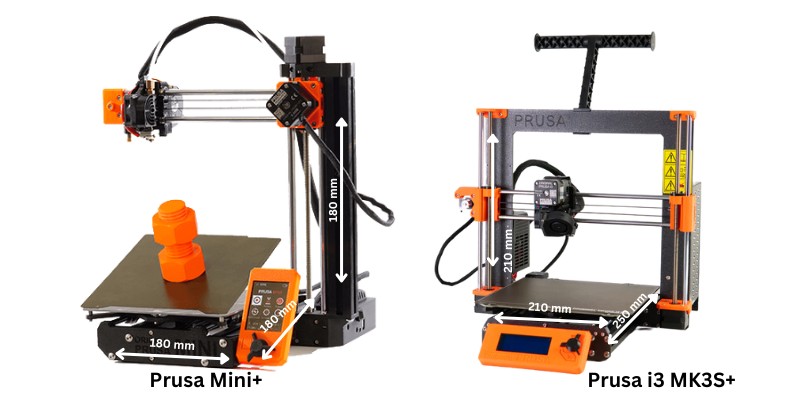
Layer Height
| Prusa printer | Layer Height |
|---|---|
| Prusa Mini+ | 50 to 250 microns |
| Prusa i3 MK3S+ | 50 to 350 microns |
The i3 MK3S+ has a slightly wider range when it comes to layer height. It caps out as 350 microns as opposed to the Mini+’s 250 micron maximum. Still, we feel that it’s unlikely this difference is going to be meaningful for the quality of your prints.
Ultimately, you’ll likely have access to the layer height you need to succeed regardless of which printer you choose in this scenario. It’s not a limiting factor or a major improvement.
Extruder Type
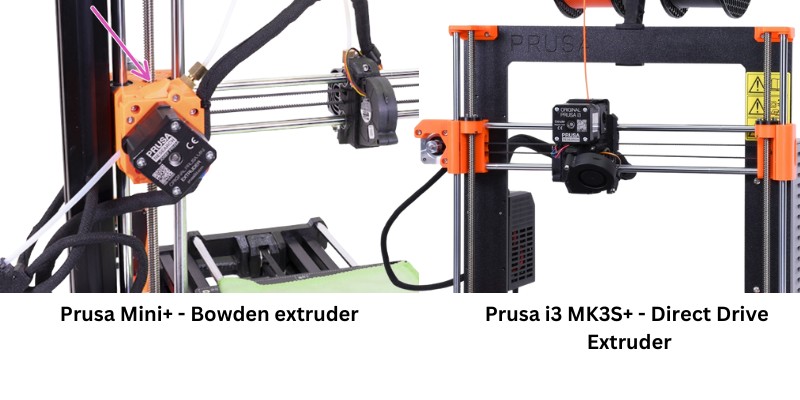
A big difference between the Mini series and the i3 series is the type of extruder they use. In the former, you’ll be working with a Bowden extruder. The latter series uses direct drive extruders.
There are many who consider the direct drive extruder to be a purely better alternative to the Bowden extruder, but it does have some downsides. For example, direct drive extruders tend to be more difficult to maintain since it’s harder to access all of the parts.
One of the benefits of the i3 Mk3S+ over prior i3 models, though, is that it uses an improved direct drive extruder form that’s intended to be easier to perform maintenance on or upgrade.
Another point in favor of a Bowden extruder is that the printhead (which doesn’t directly hold the extruder) is lighter. It can move quickly and might be quieter– although how much depends on a variety of factors like the project, the printer itself, and so on.
Overall, we’d still say that the direct drive is an improvement in this situation. A direct drive extruder often sidesteps extrusion-related problems, which makes troubleshooting significantly easier.
If you’re looking to start up a print farm, the last thing you want is to have to do more troubleshooting or tinkering on your collection of printers. We also have a more comprehensive guide on the difference between these two types of extruders.
Max Extruder and Bed Temps
| 3D Printer | Print Bed Temp | Extruder Max Temp |
|---|---|---|
| Prusa Mini+ | 100°C | 280°C |
| Prusa i3 MK3S+ | 120°C | 300°C |
The difference isn’t huge, but it’s a meaningful one. Between the MK3S+ and the Mini+, the MK3S+ has higher temperature tolerance across the board.
A max extruder temperature of 280°C on the Prusa Mini+ gives it access to a variety of basic and easier to use filaments. The print bed is a little restrictive, at 100°C.
But neither of those max temperatures allow for the same kind of flexibility as the MK3S+ when it comes to which filaments you’ll be able to use. As a higher quality printer, it has access to a maximum extruder temperature of 300°C and a print bed temperature of 120°C.
Filament Compatibility
You might think that you’re fine with using the Mini+ so long as you don’t want to use highly specialized filaments like carbon fiber or nylon. Unfortunately, the Mini+’s features (or lack thereof) can result in struggling with easier filaments, too.
The direct drive extruder of the i3 MK3S+ is usually a better bet for flexible filaments like TPU. Plus, being able to heat filaments like PP and PC up to higher temperatures can resolve some potential issues you’ll run into while printing.
All in all, it’s safe to say that the MK3S+ has a drastically larger pool of filaments to work with. The Mini+ is just not built for working with specialized filaments.
If you’re interested in operating a print farm, the i3 MK3S+’s range of filaments will give you more options for product designs. On the other hand, though, the Mini+ could be perfectly functional if you know your products will never use fancier filaments.
Upgradeability
It feels like the cheaper Mini+ is ripe for upgrades, seeing as it falls behind in most feature and spec comparisons. But it mostly benefits from an upgrade to the hot end in the extruder to make it more resilient, and not much else.
Without some serious effort, it would be difficult to outfit the Mini+ with an extruder that can handle special filaments. You also can’t really upgrade the build volume, which is the biggest downside of the printer.
Upgrades that are available to the i3 series, like the Multi-Material Upgrade 2.0, don’t work for the Mini series because of the different extruder type.
To help the Mini+ along with filaments like ASA or PP that really benefit from high temperatures and a warmer printing environment, you can use the official Prusa enclosure.
It was originally built to fit the i3 MK3S+, but in a pinch it could easily work for the Mini+. You do also have the option of using an enclosure specifically for the Mini+, like those that are offered by Tukkari.
There are actually a wide variety of Prusa enclosures out there beyond the ones we mention here, which we’ve written about in our DIY prusa enclosures article.
All things considered, the two printers are quite similar in terms of how upgradeable they are. The MK3S+ has slightly more options, but also has less need of an upgrade in general. Plus, you’re not as likely to have room in the budget for upgrades if you opt for the pricier MK3S+.
Price
| 3D Printer | Price (Kit / Assembled) |
|---|---|
| Prusa Mini+ | $429/$459 |
| Prusa i3 MK3S+ | $799/$1,099 |
Despite the many advantages of the i3 MK3S+, the price difference might be enough to tip the scales in favor of the Mini+. This is especially true if you need to purchase a larger number of printers, or you’re new to the 3D printing scene and would prefer a budget option.
Even the semi-assembled version of the Mini+ only costs $459. That’s around half the price of just the non-assembled kit version of the Prusa i3 MK3S+. With a $400-$500 difference between them (depending on the version you purchase), the price contrast is nothing to scoff at.
With the Mini+, you could purchase two for every single MK3S+. The fully assembled version of the MK3S+, which costs $1,099, does come with a discount on future printer and filament purchases of 10%.
In fact, the kit version also comes with a discount. It’s smaller than the assembled version at 5%. This bonus really helps even out the costs a little over time, but it would definitely take a while to ‘make back’ your money through filament discounts.
Prusa Mini+ vs Prusa i3 MK3S+– The Bottom Line
The Prusa i3 MK3S+ is the superior printer when purely comparing specs. It’s more reliable thanks to the direct drive extruder, has a wider range of filaments, and has a larger build volume.
As an alternative for smaller budgets and newer hobbyists, the Mini+ still has a place in the market. It won’t give you too much trouble, and if you ever want to build a print farm in the future, the Mini+ will work just fine.
Essentially, the i3 MK3S+ is the printer for you if you want the strictly better features it offers. The Mini+ is more than good enough if you aren’t planning on using specialty filaments, making large prints, and don’t mind the occasional tinkering.
Both printers are reliable and hardworking. So long as you’re okay with their limits, they won’t let you down. They’re two of the best Prusa 3D printers around, and whichever you choose, you’ve made an excellent choice.
Beyond comparing the Prusa i3 MK3S+ vs the Prusa Mini+, you may also be interested in a comparison between the Prusa Mini vs Ender 3 printers.
